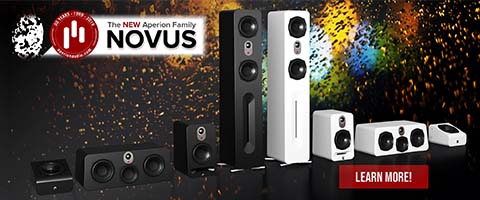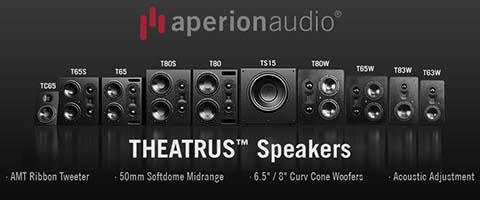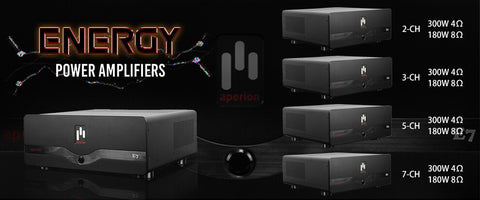 Selecting a home theater receiver can be a real challenge. Being bombarded with models and terms and specifications is enough to make you pass out! With that in mind, we present our handy course on choosing a home theater receiver.
Selecting a home theater receiver can be a real challenge. Being bombarded with models and terms and specifications is enough to make you pass out! With that in mind, we present our handy course on choosing a home theater receiver.
Before you’re ready to spend your hard earned cash, you should ask yourself a few questions. What speakers are you using? How many? How big is your room? What is the sensitivity of those speakers? What do you want to accomplish with your system? Do you watch more movies or listen to more music? Let’s dig into some of the common factors that come into play when selecting a receiver.
- - - - - - - - - - - - - - - - - - - - - - - - - - - - - - - - - - - - - - - - - - - - - - - - - - - - - - - - - - - - - - - -
Speaker Size and Recommended Power
Knowing which speakers you’re using or preparing to purchase is very important. We certainly hope they’re from Aperion Audio, but we understand if they’re not – perfection takes time. The first thing you need to consider is size. The size of your speakers makes a difference in how much power they need. You’re not going to need the same amount of power to run satellites as you will with tower speakers. Take a look at the manufacturers recommended power rating for your speakers. Most recommend between 25 and 400 watts — some even more. Try and pick a receiver that can deliver a constant amount of power within the recommended rating, so if a speaker requires between 25-150 watts, a receiver that can put out 45-100 would suit you very well. Keep in mind you don’t need 150 watts to make that speaker sound fantastic. Also, it’s important to ask yourself how many speakers you’ll be using. A two-channel stereo setup and a 7.1 channel setup have totally different power needs.
- - - - - - - - - - - - - - - - - - - - - - - - - - - - - - - - - - - - - - - - - - - - - - - - - - - - - - - - - - - - - - - -
Power Requirements (What’s the deal with Watts?)
When you are looking at receiver specifications for power ratings, you’ll notice a few things. Most receivers list around 100 watts per channel, and can cost anywhere from $150 to thousands of dollars. But wait, you’re probably saying, “100 watts is 100 watts, right?” Not exactly. Currently there are vague rules for how receiver companies rate power output. As a result, certain receivers that list 50 watts per channel may output more power than one that lists 100 watts per channel (and these types of lower-but-better-power receivers are typically of higher quality.)
- - - - - - - - - - - - - - - - - - - - - - - - - - - - - - - - - - - - - - - - - - - - - - - - - - - - - - - - - - - - - - - -
Receivers vs Amplifiers
Receivers are essentially a preamp and amplifier shacked up together in the same box. Amplifiers generally don’t change drastically from year to year. Preamps and all of the audio and video processing does. The advance of audio and video quality over the past few years has been tough to keep track of. For home theater surround sound in particular, it is important to look for a receiver fluent in Dolby Digital, and DTS. If a receiver has these two sound modes, then most likely they will have quite a few others to play around with, like Dolby Pro-logic for example. To take advantage of these surround modes your receiver will have either optical input and coaxial digital inputs, or both. It doesn’t matter which one you use, just make sure you use one of them when connecting your devices.
- - - - - - - - - - - - - - - - - - - - - - - - - - - - - - - - - - - - - - - - - - - - - - - - - - - - - - - - - - - - - - - -
Video Switching
Video switching is a real selling point for receivers. First there was composite video switching, allowing you to use your receiver as the hub of your entertainment system. But as video quality improved, so did receivers and connections. Then came s-video, followed by component video and DVI switching. Currently HDMI switching and high definition video up-conversion is the rage. What is HDMI? High Definition Multimedia Interface, or HDMI, passes multi channel audio and high definition video over one cable. The convenience of up-conversion is that you can plug any type of video connection into your receiver, which is up-converted to HD and sent to your display, this equals less cables and a better picture. The only disadvantage is your TV must have an HDMI input. Soon (fingers crossed) HDMI will work itself out as the gold standard for audio and video connections, it’s off to a great start, but needs wider support both on the receiver and TV ends.
- - - - - - - - - - - - - - - - - - - - - - - - - - - - - - - - - - - - - - - - - - - - - - - - - - - - - - - - - - - - - - - -
Music vs. Home Theater
The majority of receivers do a great job reproducing movie and music soundtracks equally. However, there are companies that offer better quality amplifiers for serious two-channel stereo listening, sacrificing other surround sound or video switching features used in home theaters. Receivers that put music first are more difficult to find, usually either a separate two-channel receiver or amplifier is the solution. Most integrated receivers you will find are geared toward home theater and surround sound. There are more and more multi channel CD’s, DVD’s and especially video games that take advantage of a complete surround sound system.
- - - - - - - - - - - - - - - - - - - - - - - - - - - - - - - - - - - - - - - - - - - - - - - - - - - - - - - - - - - - - - - -
In Conclusion
So, how do you know which one to buy? The quick answer is to do your homework, which you are doing right now (well done!) More specifically, read reviews of different receivers, see what other owners have to say about them. You can find forums where you can post specific questions (and most of the time, get a couple of great responses.) Above all else, give it a listen. Play with its features and decide what sounds good to you, not just what has the highest review. The only thing that truly matters is how it sounds to you – trust your ears and your needs, and you’ll be just fine.

Complete Your Sound System Solution

Sign up for our newsletter below, and join our social media groups to stay up to date with the latest news and information from Aperion Audio!
 |
 |








 https://www.aperionaudio.com
https://www.aperionaudio.com
4 comments
DO YOU DO HOME EVALUATIONS?
I have a Denon s760h ,75watts. I’m pairing them with the Klipsch r625fa theater combo system 100w-400 . Does my receiver have enough power to push them to sound good and not damage the speakers or the receiver.
I have a Denon s760h ,75watts. I’m pairing them with the Klipsch r625fa theater combo system 100w-400 . Does my receiver have enough power to push them to sound good and not damage the speakers or the receiver.
This explanation seems to be addressed to real or would be aficionados of audio systems. For the average user, who just wants an output that is sufficient to provide him with enough volume to allow him to listen, for example, to an amplified television audio output without disturbing the neighbors, what would you say is a reasonable output power?
Incidentally, I’m a telecomms engineer, so feel free to “talk technical”.